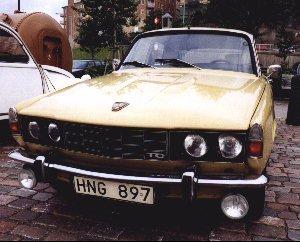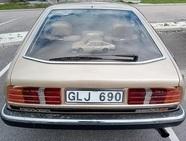Rovermanualer
Roger Dealtry har en site om Rover P4, med många tips och mycket hjälp för reparationer och renoveringar.
Den finns härRoger Dealtry har en site om Rover P4, med många tips och mycket hjälp för reparationer och renoveringar.
Den finns härHaynes webbsite. De har tryckta manualer för de flesta moderna Roverbilar.
Hos Moss kan man få ett supplement för Rover 620 ti.
Finns här
0 General
There are some easy "Smokesigns" to help locate engineproblems:
Grey smoke:Wrong ignition timing or too fat carburettor settings
Black or blue smoke: Burned oil (from worn valve guides - less oil consumption; worn pistons - exessive oil consumption; defective headgasket or cracked cylinder head)
White smoke: Water in cylinder (from worn head-gasket, cracked head)
And here's a test to do:
With the engine cold, cover the exhaust pipe with a rag and start the engine. After a few minutes, remove the rag and inspect the gunk it filters out. If the outside temp isn't too high, the rag will usually be covered with condensate (water) and some soot from the combustion process.
If it has a layer of irridescence or outright oil floating on top, you have a problem.
You can also see if the problem is water (instead of oil) by starting the engine when cold, and immediately inspecting the radiator. If the engine head is leaky, there will be instant pressure of the cooling system, or sometimes oil on the top of the coolant.
Normally, black smoke out of the exhaust pipe is just too rich a carb mixture - and easily fixed.
If the results are oil from the tailpipe, then engine diagnostics are in order to find out where it is coming from - you can do a compression check. If there are any low pressure cylinders, squirt some oil into the spark plug holes, and do the compression check again. If the pressure rises, you have bad rings. If the pressure is still low, then your problems are in the head.
This will give you some ideas as to how big the repair project and it's related expenses will be.
Thanks to Rovernet, Rolf Schröder, rschroed@canon.de and John P Dunlap, SNOHOMISHARTS@prodigy.net.
1 Engine
2 Cooling system
Rovers have a strong tendency to get an airlock in the heating system. You need to bleed it, just as you would brakes. With the engine running, loosen the top heater hose and slip it slightly off the metal tube until the water runs fully with no bubbles. You'll need to have someone simultaneously topping the radiator while you do this. And you'll have to do it every time the radiator gets a bit low. I have to do mine a couple of times a week if I want reliable heat. You can make the job a bit easier by drilling a small (1/16") hole in the tube where it will be covered by the hose. Then you can slide the hose back just a little to bleed it. I've been meaning to put some sort of valve on mine but haven't gotten around to it yet.
Another way to cure the heater problem is to fit a radiator recovery tank to the engine compartment. No air - no air lock.
Thanks to Robert Arnold and John P Dunlap
Removing the heater box
This is an non air con V8. a/c and 2000s are different.
1. Disconnet the battery
2. Remove the wipers.
3. Remove the windscreen valance.
4. Open or remove (not necessary but makes it easier) both glove boxes.
5. With a really long extension and a 5/16" socket feed the extension in behind the radio unit from the right hand side while you look and grope on the left hand side to loosen bolts joining the heater forks to the top/bottom - hot/cold levers.
6. Using two 5/16" spanners disconnect the fan lever from the heater box tang.
7. Remove the air cleaner.
8. Remove the coolant hoses from the heater (if yours are stuck it could take longer). Remove one hose entirely and reconnect the other to the engine. NOTE: One hose tapers from the engine. Leave that one on the engine.
9. Disconnect the three wires from the right hand side of the heater box.
10. Undo the four bolts holding the heater box in.
11. Man handle the darn thing out.
You my also need 10a unbolt the throttle linkage bracket but I can't remember doing that in the V8.
Of course then you want to remove the heater core and that's real fun and games.
Another thing that can go wrong is the linkage spindle can break internally so that the lever does practically nothing.
Thanks to: Gavin Walker
Engine sideplates for 2000 and 2200 engines
The original sideplates are of conventional iron/steel and corrode fairly fast - compared to the rest of the engine and car. There are also examples of these plates in stainless steel - and they seem to work great and have revealed no troubles after some years of use.
Try Wadhams or Walkers to get a new plate that fits.
Fitting new sideplates on 2000/2200 SC & TC
This is a description of how to change the engine side plates on the above cars. Sizes given are AF spanner sizes not thread sizes. I shall concentrate on the O/S (oil pump/distributor) side of the engine, as this is the most difficult. There is no difference on this side between SC/TC (unless you have an oil cooler fitted).
First drain the water then remove the long bolt, which holds the engine mount arm to the inner wing.
You can then place a jack under the sump to raise the engine until the weight of the engine is off the mount, remember to spread the load using a block of wood or something similar and if possible use a bottle jack as you may need room to crawl underneath later.
Remove the two top 9/16th nuts securing the mount to block, one also secures the earth strap. Then working underneath the car remove the four 7/16th bolts holding the two armored oil pipes to the engine block, this will allow access to the lower engine mount 5/8th bolt which when removed will allow the mount arm to be wiggled free. It may be necessary to raise the engine slightly on the jack to get it out. You will then see two studs, which are much wider near the plate and fitted with a 15/16th nut. This is the awkward part, you will need a DEEP socket to get over the stud and it is likely it will not then go over the nut as it fouls the raised flange that is on the edge of the plate. There are two ways to approach it.
If you have a stud extractor you could try to remove studs and nuts in one 'hit', alternatively you can probably get enough purchase with an open-ended spanner to remove the nut, which will often bring the stud out with it or, if not, you will still need to remove the studs afterwards. If you don't have a stud extractor replace the two 9/16th nuts and using two spanners 'lock' them together, then try to turn it out putting the spanner on only ONE nut. This should do the job.
You now need to remove the ring of 3/8th bolts that hold the plate to the block; the difficult bit here is the lack of room behind the oil pump. You can gain additional room by removing the three 1/2" nuts that hold the pump to the housing as well as the timing chain tensioner oil feed pipe and withdrawing it along with the pipes still attached but the part nearest the front of the engine is still tight, more about that in a minute.
So having removed all the bolts the plate will either fall off or be persuaded to fall of with a screwdriver. It is essential that you now CLEAN THE BLOCK. Yes I know its a gutty job but out with the wire brush/wool until NO trace of old gasket remains.
It is also a good idea to remove all the sludge that will have built up between the liners, if your outside you may want to flush with a hose. Now you're ready to re-assemble. I use Blue Hylomar as a sealant but you may have your own preference, if your using a second-hand plate or repairing the original then make sure it is suitably clean. The plates can be repaired by having really hacked at it to reveal all the 'perforations' (it will probably have more than your tea-bags) and giving it a taste of a wire brush in a drill to clean what surfaces remain, get your local friendly welder to 'float' some brazing metal into the holes. I had mine done ten years ago and its still holding water.
Offer the plate up to your gleaming clean block and put in some bolts top/bottom/side to locate the plate and gasket. Do not fully tighten yet. You will now see that those bolts you undid behind the oil pump until they dropped on the floor are impossible to get back in unless you have fingers like ET.
Dont worry the solution is as follows, magnetize a screwdriver until it has enough attraction to hold a bolt. If you don't have a magnet handy you can use the back of a speaker, remember stroke the screwdriver over the magnet in ONE direction only lifting off at the end of each stroke. You will now be able to 'stick' the bolt to the screwdriver at right angles. Lower the screwdriver behind the pump until opposite the hole then using the screwdriver as a lever push it against the pump housing and thus the bolt into the hole whilst at the same time turning the bolt with a spanner.
You may find the average spanner is not long enough to reach so you may need to just bind it to another using a decent tape, don't worry we are only using very small forces and once the bolt is located you can use the spanner on its own for the final tighten. I think there are three or four bolts in this location that are problematical but they can be done.
Try to tighten all the bolts in an even manner so the plate is pulled home 'square', remember they are only small so no Rambo impressions when tightening.
The rest of the re-assembly is straightforward reversal of removal. Watch the two O rings on the oil pipes haven't fallen out, they should be OK to re-use but if you prefer order replacements before starting.
The other side is more straightforward but does require removal of the exhaust manifolds on both models and it is easier with the inlet manifolds/carbs removed on TC models.
I have come across many a P6 with this problem, unfortunately some owners prefer a weekly radiator top up to curing the cause, the end result is usually a weak or non-existent anti-freeze mixture which quickly accelerates cylinder head corrosion resulting in blown head gasket and ruined cylinder head, all because the plate is leaking. A straightforward change can easily be accomplished on a Saturday morning, but the again when were P6's ever 'straightforward'. But then ain't that why we love 'em?
Alan Francis (Part Viking)
Fixing pinholes
If you have trouble with small waterleaks Eric Russell gives this story and advice:
I traced a waterleak to a pin hole in the side cover. I was recommended the following which worked for about 3 years until I took it off the road and replaced it with my first, real, restoration:
1. Remove the water from the engine before you begin 2. Obtain a fine, sharp, centre punch that will enter the pin hole and expand it slightly.
3. Locate a new, stainless steel, metal, self tapping screw that will start in the pin hole which would be slightly expanded. Also get a washer to fit.
4. Obtain a thin sheet of rubber to be used as a gasket. Cut to fit the washer, above.
5. Holding the breath and praying to one's god, slightly tap the hole punch into the pinhole. I put masking tape around the centre punch to predetermine the depth. I compared the size and shape of the screw to the center punch shaft below the tape.
6. I assembled the rubber gasket, then the washer, and fitted the screw.
7. Carefully fit the screw into the expanded pin hole.
8. Refill the water in the engine and turn the ignition.
9. The water stopped running and the problem was temporarily solved for three years.
Note: If the hole is bigger than a pinhole, a larger screw would work.
Eric
3 Fuel system and carburation
4 Ignition system
Had a win with the P6B this past weekend.
It was time to fit new points and condenser, as the car had come to a halt a couple of weeks previous and investigation revealed that the points had closed up. We got the car going satisfactorily, but new points were definitely needed as the adjustment was all used up and the contacts were quite pitted. An overly "sparky" spark suggested that a new condenser might be a good investment as well.
Please bear in mind that the car's most recent tune-up had been at a garage where they appeared to know what they were doing. You pay your money and take your chances, it seems.
A closer look at the distributor revealed that turning the rotor against the balance weight springs did not automatically result in the rotor "springing" back against the tension. So I pulled the distributor apart in-situ to find that the shaft that fits inside the rotor spindle was gummed up and was unable to give any centrifugal advance at all. It looks to have been that way for quite a while, too. Not a matter of abuse, more one of old lubricant and lack of attention by those paid to do a job.
Cleaned it up, lightly oiled, and the action is again nice and smooth as the maker's intended. Time for a road test, and the car is "pinking" like crazy at any suggestion of acceleration. On-road testing and road-test adjustment of the timing resulted in me retarding the timing almost a full firing stroke! The garage must not have bothered to see if their timing light revealed any advance or difference between idle and revs. How long had it been like this?
Now the car can advance its own timing and the car runs much better than it has for quite a while. A very simple check on your car (any car) with zero parts cost and an excellent result if you find the same problem. Just be careful not to drop the little screws that distributors are full of.
Thanks to: John Graham
Mail him at: jgraham@pioneeraus.com.au
5 Clutch and actuating mechanism
6 Gearbox and automatic tranmission
7 Propeller shaft and universal joints
UNBOLTING DRIVESHAFTS
Having first loosened the outer nut on the end of the driveshaft (in the centre of the rear wheel hub), jack up the rear of the vehicle, and release the locking tabs on the (four) inner bolts through the brake disc.
Place a 5/8 ring spanner of suitable length on the bolt heads (in turn) so that the other end of the spanner bears against the de dion tube (cushion this with a block of wood, or similar) and turn the road wheel itself to exert force on the bolt.
IT WORKS!! ...and you don't get a hernia or drag the car off the jack stands.....
A pearl of wisdom from the land of Ozrover.
Peter Harris
8 Rear axle
9 Braking system
10 Electrical system
11 Suspension, dampers and steering
12 Bodywork and underframes
RUST CARE
Read Ian Harrison's article about the weak points of the P6.
MAINTAINING LEATHER SEATS
We had a local well respected upholserer give a talk at a club night on the care of leather, in his opinion the worst enemy of leather upholstery was body sweat and general grime. His recommendation was regular cleaning with a damp cloth and perhaps a non detergent type soap and then treatment with one of the recognised leather foods such as that produced by Connolly"s.
Once the colour coating has gone there is little that can be done by the amateur to restore the leather. The only satisfactory answer is to strip off the remaining traces of the colour coating and then recoat with new colour, a job for profesionals. I had our P5B Coupe seats treated this way and the end result is like new.
John Adam (Secretary, Wellington Car Club)
CRACKING DASHBOARDS
In many parts of the world the dashboards crack. In warm parts of the world due to heat and in cold parts due to the cold.
In Melbourne Australia there are a couple of firms specialising in re-making cracked dashes, and they do a good job.
If you want help with this I suggest you contact a Rover Club in Australia to find one of these firms.
13 Supplement: Revisions and information on later models

(medlemsavgiften är betald)

Den israeliske konstnären Ron Arrard stöpte om P6-stolen till modern konst. Paul Vissers har gjort ett bord av en Rover V8-motor.

Rover byggde portabla bensindrivna vattenpumpar för brandbekämpning åt Royal Navy. De hade fyra cylindrar och startades med handkraft.

Har du bilder från Rover-träffar?
Saknar du bild på din Rover i "Galleri/Medlemmars bilar"?
Har du tips på Rover-träffar?
Skicka dina bilder/tips till Webmaster
Cigarren sysselsätter både händer och mun. Därigenom har jag många gånger undgått frestelsen att antingen strypa eller bita folk som irriterat mig.